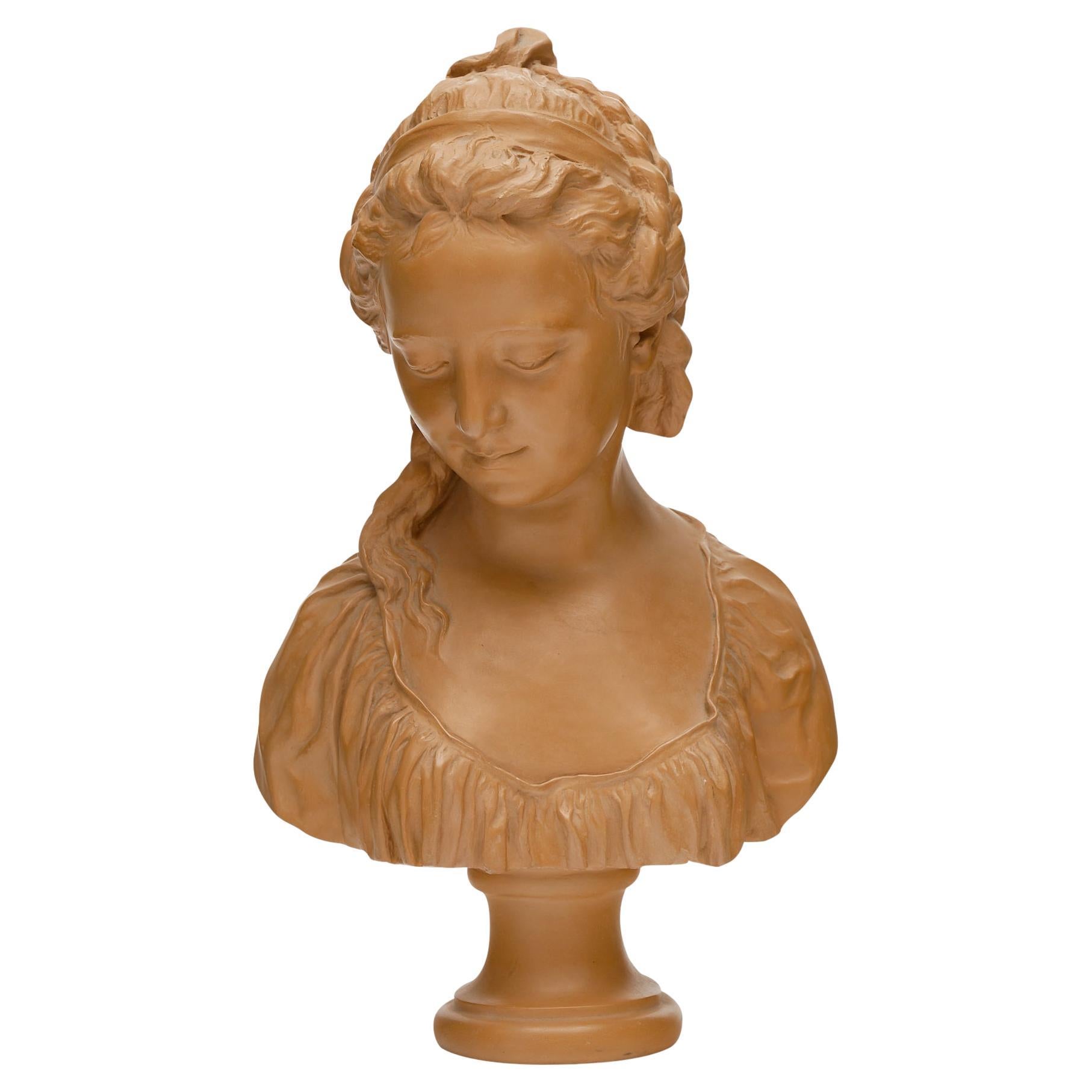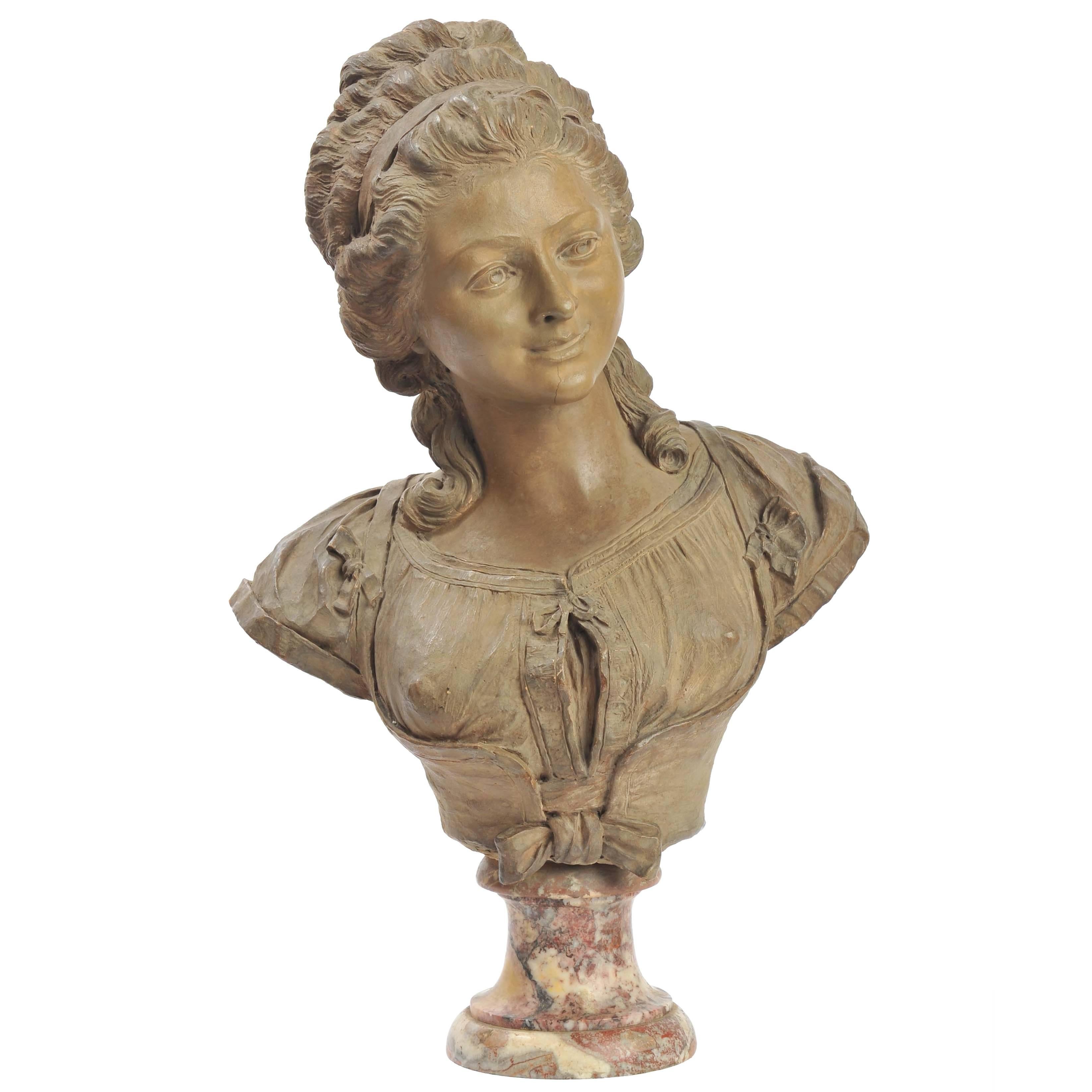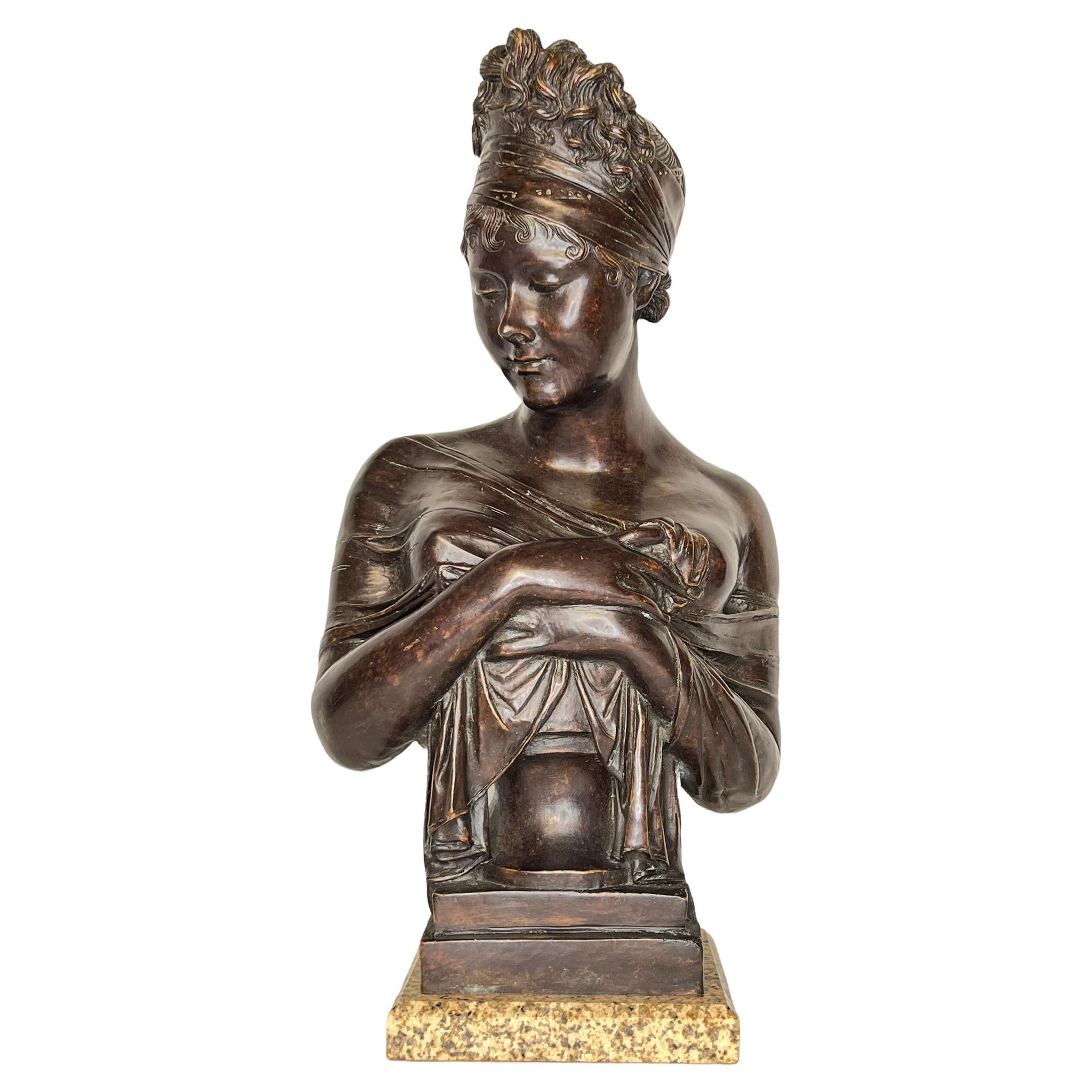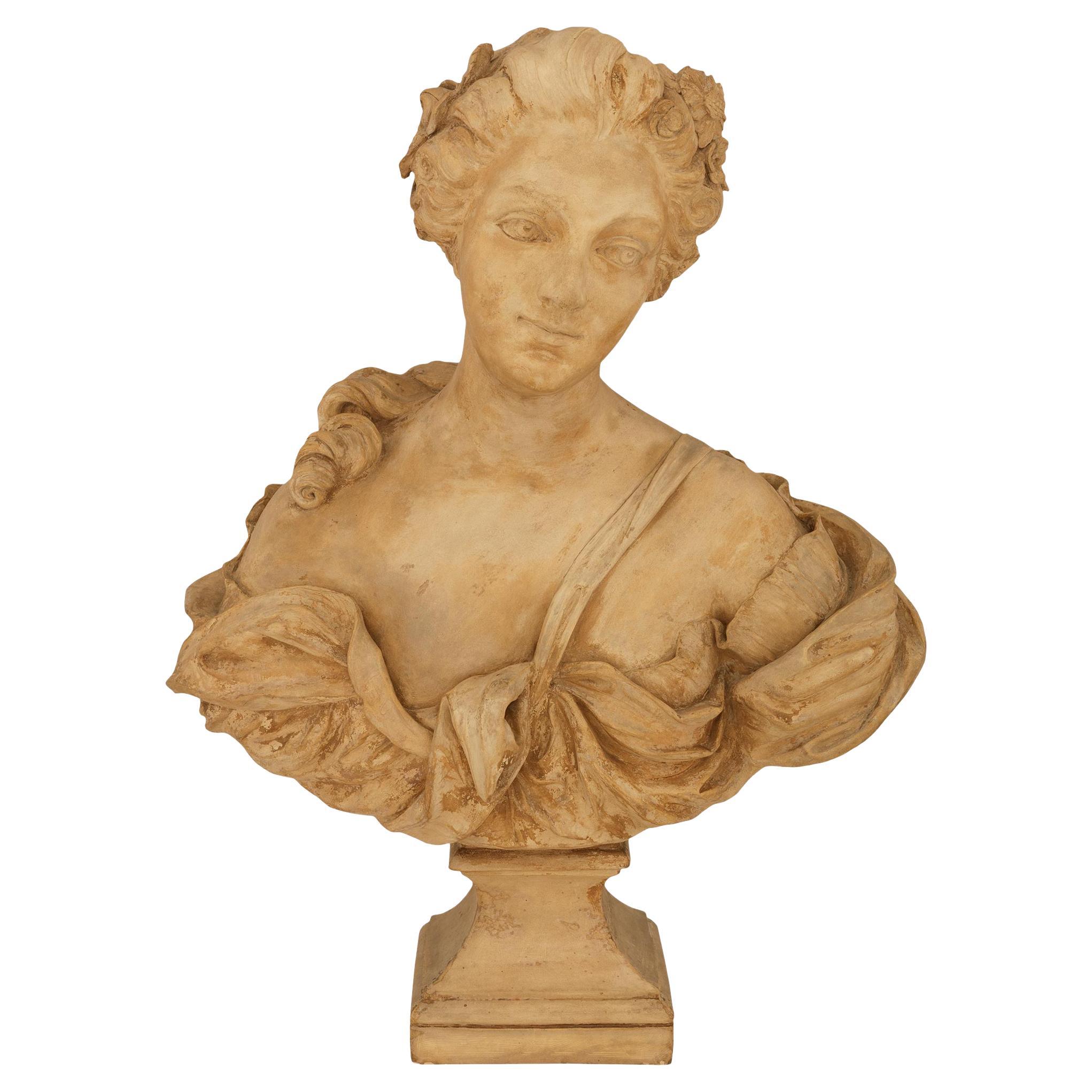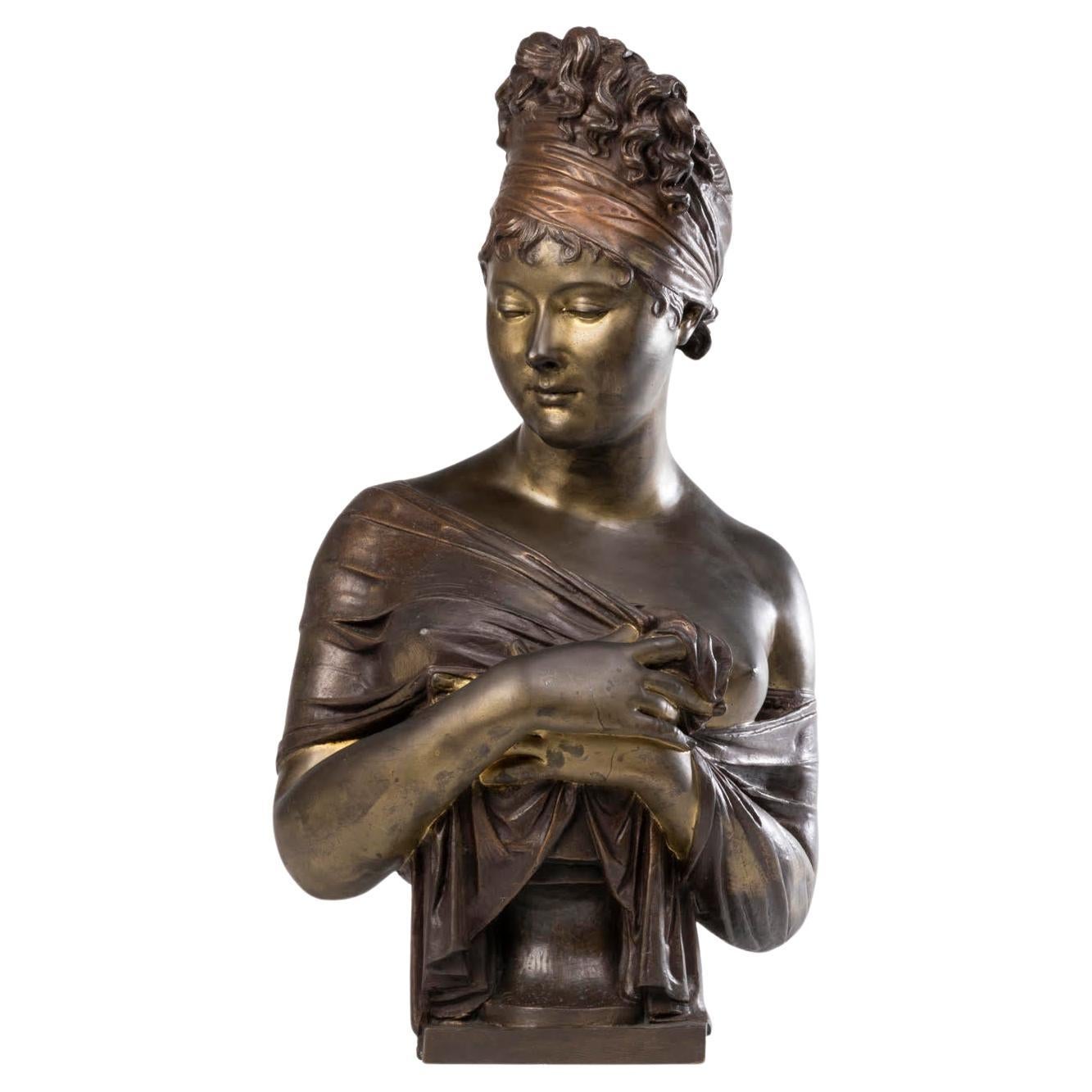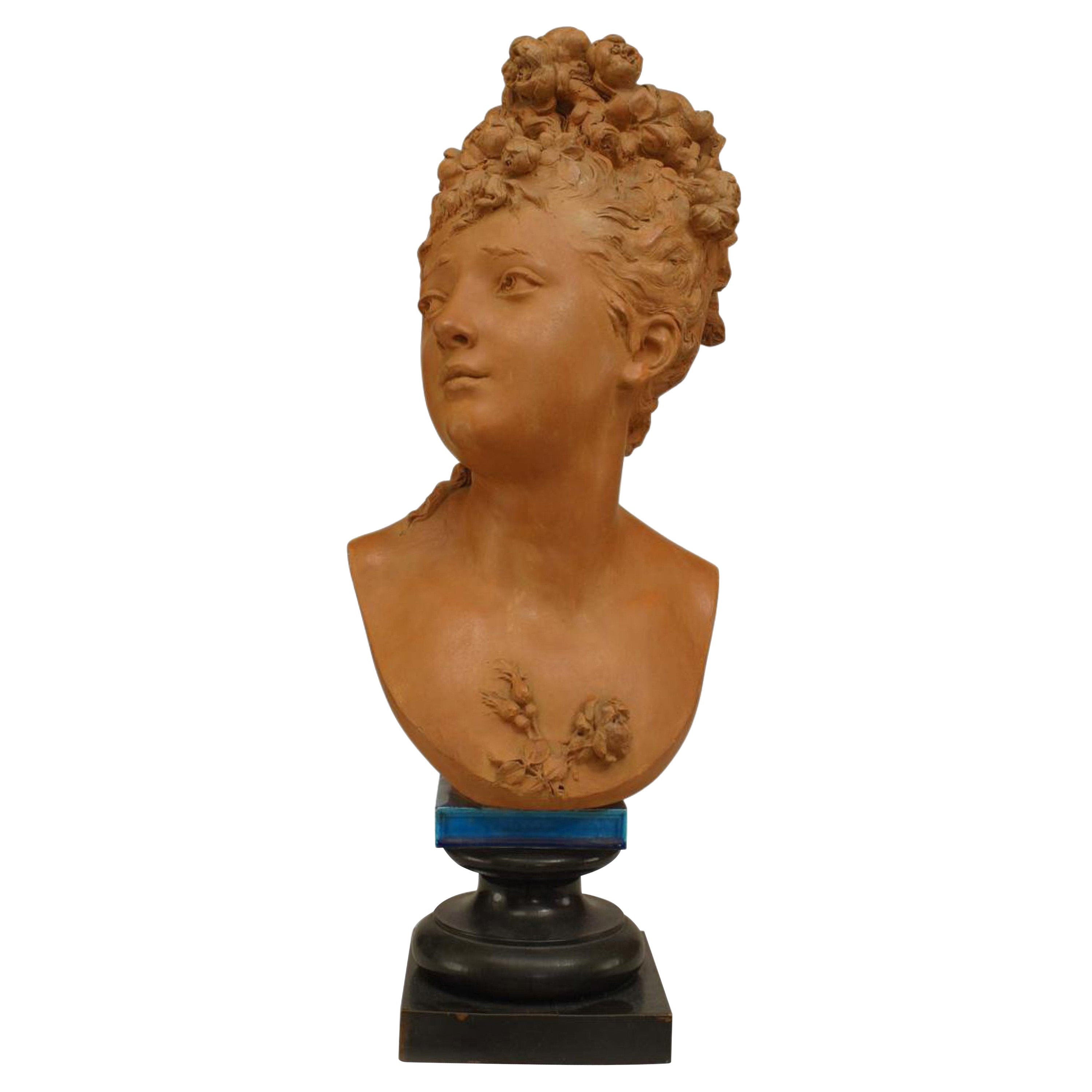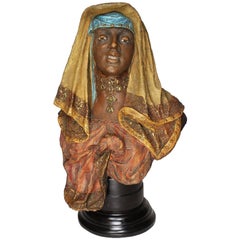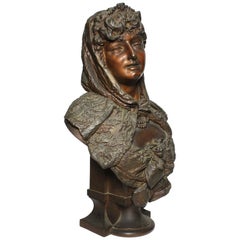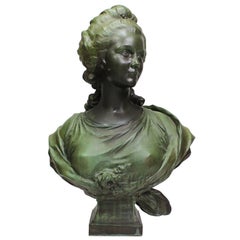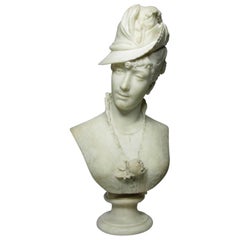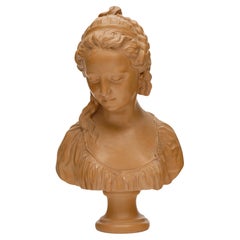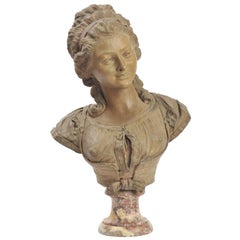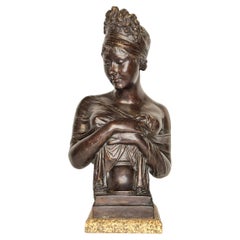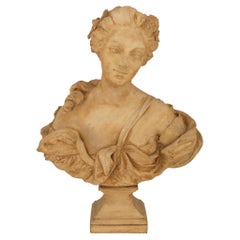Items Similar to French 19th Century Terracotta Bust of Madame Récamier, After Jean-Antoine Houdo
Video Loading
Want more images or videos?
Request additional images or videos from the seller
1 of 12
French 19th Century Terracotta Bust of Madame Récamier, After Jean-Antoine Houdo
$6,450
£4,863.94
€5,625.38
CA$9,049.32
A$10,058.88
CHF 5,272.65
MX$122,843.22
NOK 65,825.96
SEK 61,929.95
DKK 41,986.20
About the Item
A fine French 19th century terracotta bust of "Madame Récamier (French, 1777-1849)" The coyly gazing downward beauty, holding a veil across her chest revealing her bosom, the veil gently falling over the integral socle, her hair bound with a cloth wrapped around the head, curls falling over the top, signed on the base HOUDON, after the model by Jean-Antoine Houdon (French, 1741-1828), Paris, circa 1880.
Height: 22 3/4 inches (57.8 cm)
Width: 12 3/4 (32.4 cm)
Depth: 10 inches (25.4 cm)
Jeanne-Françoise Julie Adélaïde Récamier (4 December 1777 – 11 May 1849), better known as Juliette, was a French socialite, whose salon drew Parisians from the leading literary and political circles of the early 19th century. A native of Lyon, Jeanne-Françoise Julie Adélaïde Bernard was the only child of Jean Bernard, the King's counsellor and a notary, and his wife, the former Marie Julie Matton. In 1784, her father became the French receiver of finance. She was educated at the Couvent de la Déserte in Lyon briefly, after which her family moved to Paris.
Jean-Antoine Houdon (French, 1741-1828) was a French neoclassical sculptor.
Houdon is famous for his portrait busts and statues of philosophers, inventors and political figures of the Enlightenment. Houdon's subjects include Denis Diderot (1771), Benjamin Franklin (1778-09), Jean-Jacques Rousseau (1778), Voltaire (1781), Molière (1781), George Washington (1785–88), Thomas Jefferson (1789), Louis XVI (1790), Robert Fulton, (1803–04), and Napoléon Bonaparte (1806).
He was born in Versailles, on 25 March 1741. In 1752, he entered the Académie royale de peinture et de sculpture, where he studied with René-Michel Slodtz, Jean-Baptiste Lemoyne, and Jean-Baptiste Pigalle.[1] From 1761 to 1764, he studied at the École royale des élèves protégés.
Bust of the Marquis de Miromesnil, 1775 CE. From Paris, France. By Jean-Antoine Houdon. The Victoria and Albert Museum, London
Houdon won the Prix de Rome in 1761, but was not greatly influenced by ancient and Renaissance art in Rome. His stay in the city is marked by two characteristic and important productions: the superb écorché (1767), an anatomical model which has served as a guide to all artists since his day, and the statue of Saint Bruno in the church of Santa Maria degli Angeli e dei Martiri in Rome. After ten years stay in Italy, Houdon returned to Paris.
He submitted "Morpheus" to the Salon of 1771. He developed his practise of portrait busts. He became a member of the Académie de peinture et de sculpture in 1771, and a professor in 1778. In 1778, he modeled Voltaire, producing a portrait bust with wig for the Comédie-Française; one for the Palace of Versailles, and one for Catherine the Great.
In 1778, he joined the masonic lodge Les Neuf Sœurs, where he later met Benjamin Franklin, and John Paul Jones. For Salon of 1781, he submitted a "Diana" which was refused without drapery.
Bust of Washington based on a life mask cast in 1786, National Portrait Gallery, Washington, D.C.
Houdon's portrait sculpture of Washington was the result of a specific invitation by Benjamin Franklin to cross the Atlantic in 1785, specifically to visit Mount Vernon, so that Washington could model for him. Washington sat for wet clay life models and a plaster life mask. These models served for many commissions of Washington, including the standing figure commissioned by the Virginia General Assembly, for the Virginia State Capitol in Richmond. Numerous variations of the Washington bust were produced, portraying him variously as a general in uniform, in the classical manner showing chest musculature, and as Roman Consul Lucius Quinctius Cincinnatus clad in a toga. A cast of the latter is located in the Vermont State House.
Perceived as bourgeois for his connections to the court of Louis XVI, he fell out of favour during the French Revolution, although he escaped imprisonment. Houdon returned to favor during the French Consulate and Empire, being taken on as one of the original artistic team for what became the Column of the Grande Armée at Wimille. He was made a Chevalier de la Légion d'honneur, on 17 December 1804.
- Similar to:Jean-Antoine Houdon (Sculptor)
- Dimensions:Height: 22.75 in (57.79 cm)Width: 12.75 in (32.39 cm)Depth: 10 in (25.4 cm)
- Style:Neoclassical (In the Style Of)
- Materials and Techniques:
- Place of Origin:
- Period:
- Date of Manufacture:circa 1880
- Condition:Wear consistent with age and use. Minor fading. A truly beautiful bust of Madame Recamier. Condition is very good, some minor age spotting and discoloration (See all images).
- Seller Location:Los Angeles, CA
- Reference Number:Seller: Ref.: A22341stDibs: LU179628359833
About the Seller
5.0
Vetted Professional Seller
Every seller passes strict standards for authenticity and reliability
Established in 1982
1stDibs seller since 2016
135 sales on 1stDibs
Typical response time: 1 hour
- ShippingRetrieving quote...Shipping from: Los Angeles, CA
- Return Policy
Authenticity Guarantee
In the unlikely event there’s an issue with an item’s authenticity, contact us within 1 year for a full refund. DetailsMoney-Back Guarantee
If your item is not as described, is damaged in transit, or does not arrive, contact us within 7 days for a full refund. Details24-Hour Cancellation
You have a 24-hour grace period in which to reconsider your purchase, with no questions asked.Vetted Professional Sellers
Our world-class sellers must adhere to strict standards for service and quality, maintaining the integrity of our listings.Price-Match Guarantee
If you find that a seller listed the same item for a lower price elsewhere, we’ll match it.Trusted Global Delivery
Our best-in-class carrier network provides specialized shipping options worldwide, including custom delivery.More From This Seller
View All19th-20th Century Orientalist Terracotta Bust of Girl Attributed to Goldscheider
By Goldscheider Manufactory of Vienna
Located in Los Angeles, CA
An Austrian 19th-20th century Orientalist terracotta bust of a young girl in Middle-Eastern Garb. The young smiling beauty wearing a head scaft and shawl tied with a broche-pin brooch pin and jewlry around her neck, raised on a circular ebonized wood stand. Probably by Friedrich Goldscheider (Goldscheider'sche Porzellan-Manufactur und Majolica-Fabrik) - The backside stamped: "T - No. 258". circa 1900.
The Goldscheider Manufactory and Majolica Factory (German: Goldscheider'sche Porzellan-Manufactur und Majolica-Fabrik, (now) Goldscheider Keramik) is an Austrian ceramic manufactory.
In 1885, Friedrich Goldscheider came from the small Bohemian city of Pilsen to Vienna and founded the Goldscheider Manufactory and Majolica Factory. It became one of the most influential ceramic manufactories of terracotta, faience and bronze objects in Austria with subsidiaries in Paris, Leipzig and Florence. For over half a century Goldscheider created masterpieces of historical revivalism, Art Nouveau (Jugendstil) and Art Deco. Famous artists such as Josef Lorenzl, Stefan Dakon, Ida Meisinger and the two perhaps best known Austrian ceramic artists Michael Powolny and Vally Wieselthier worked for Goldscheider. Several of the artists who worked for Goldscheider also worked for other Viennese studios, such as Augarten, Keramos or for the German brands Rosenthal and Meissen.
The Goldscheider family emigrated in 1938 to United Kingdom and USA. Walter Goldscheider startet a new factory in Trenton, New Jersey and returned to Vienna in 1950. Marcel Goldscheider went to Stoke-on-Trent and produced figurative ceramics for Myott and opened his own studio in the 1950s in Hanley. Both brothers died in the early 1960s.
More than 10,000 different models were created over a period of three generations. Since the very beginning many of these won first prizes and gold medals at innumerable world fairs, exhibitions and trade fairs. Goldscheider figures...
Category
Antique Early 1900s Austrian Agra Busts
Materials
Terracotta, Wood
$4,547 Sale Price
29% Off
19th Century Patinated Spelter Bust Figure of a Young Girl, Attributed to Hottot
By Louis Hottot
Located in Los Angeles, CA
A fine French 19th century patinated spelter bust figure of a young wearing a head scarf. The young lady, in a brown-copper patina, posing with a right-side gaze and wearing a beaded...
Category
Antique Early 1900s French Rococo Revival Busts
Materials
Spelter
$4,985 Sale Price
22% Off
French 19th-20th Century Art-Nouveau Bronze Patinated Bust of Marie Antoinette
By Agathon Léonard
Located in Los Angeles, CA
A fine French 19th-20th century Art-Nouveau patinated bronze bust of "Marie Antoinette" (Queen of France 1755-1793), after the model by Agathon Léonard or Léonard Agathon van Weydeve...
Category
Antique Early 1900s French Art Nouveau Busts
Materials
Bronze
$12,450 Sale Price
34% Off
Fine Italian 19th-20th Century Lifesize Carved Marble Bust of a Posing Lady
By Antonio Frilli
Located in Los Angeles, CA
A fine Italian 19th-20th century lifesize carved marble bust of a lady wearing a hat, the beautifully carved marble bust of a lady posing with a gaze to her right, wearing a bonnet w...
Category
Antique Early 1900s Italian Romantic Busts
Materials
Marble
$9,850 Sale Price
21% Off
Fine Italian 19th-20th Century Carved Two-Color Alabaster Bust of a Young Beauty
Located in Los Angeles, CA
An Italian 19th-20th century carved color-alabaster bust of a young beauty. The finely carved two-tone alabaster bust, depicting a young girl posing with a side gaze and wavy hair ti...
Category
Antique Early 1900s Italian Country Busts
Materials
Alabaster
$4,295 Sale Price
33% Off
French 19th Century Bronze and White Marble Bust of Marianne in Full Armor
Located in Los Angeles, CA
A French 19th century bronze and marble bust of Marianne in full armor. The nicely cast Baroque Revival brown patinated bronze and carved white marble figure of Marianne, the allegorical personification of the French Republic, presented in her militaristic guise, reminiscent of Minerva, wearing a Phrygian helmet and armored breastplate centered by winged male mask and with lion shoulder armor pads, all raised on a conforming black marble base. Circa: 1890-1900.
Marianne has been the national personification of the French Republic since the French Revolution, as a personification of liberty, equality, fraternity and reason, as well as a portrayal of the Goddess of Liberty.
Marianne is displayed in many places in France and holds a place of honor in town halls and law courts. She is depicted in the Triumph of the Republic, a bronze sculpture overlooking the Place de la Nation in Paris, as well as represented with another Parisian statue on the Place de la République. Her profile stands out on the official government logo of the country, appears on French euro coins and on French postage stamps. She was also featured on the former franc currency and is officially used on most government documents.
Marianne is a significant republican symbol; her French monarchist equivalent is often Joan of Arc. As a national icon Marianne represents opposition to monarchy and the championship of freedom and democracy against all forms of oppression. Other national symbols of Republican France include the tricolor flag, the national motto Liberté, Égalité, Fraternité, the national anthem "La Marseillaise", the coat of arms, and the official Great Seal of France. Marianne also wore a Cockade and a red Phrygian cap symbolizing Liberty.
Minerva and its pendant bust of Mars evoke the classicizing subjects, bust-length formats, and style that originated in France during the reign of Louis XIV (1643–1715) and that concurrently was popularized across Europe. The busts' simple forms, stiff poses, and solemn facial types are consistent with the late Baroque sculptures that were carved in Flanders during this period. In Flanders, especially in Antwerp and Brussels, sculpture and architectural decoration traditionally was carved using combinations of native black marble (noir belge), mottled red marble (rouge belge), and white marble or alabaster. The use of these stones in colorful counterpoint speaks most strongly to the busts’ Flemish origins.
The veneration of ideal heroes and heroines in ancient costume and arms took on extravagant form in the 17th century, with countless variations. Within this imaginative tradition, the identification of the pair as Minerva and Mars cannot be certain. The female bust, for example, could be identified as Bellona, Roman goddess of war, who is depicted in 17th and 18th century French paintings wearing flamboyantly plumed helmets and low-cut cuirasses that expose her breasts. Whatever their identities, the female and male warriors are portrayed as calm rather than bellicose beings. The sovereign pair does...
Category
Antique 19th Century French Baroque Revival Figurative Sculptures
Materials
Marble, Bronze
$24,950 Sale Price
27% Off
You May Also Like
French Antique Terracotta Bust
Located in Austin, TX
Sculptural bust from France hand-crafted in terracotta. This finely detailed vintage work of art features the likeness of a woman and has a wonderful warm tone.
Category
Vintage 1920s French Art Deco Busts
Materials
Terracotta
19th Century French Terracotta Bust
Located in Brighton, Sussex
A good quality French 19th patinated terracotta bust of a classical lady, mounted on a Rouge marble sockel.
Category
Antique 19th Century French Baroque Busts
Materials
Terracotta
Madame Juliette Recamier Bronze Bust After Joseph Chinard
By Joseph Chinard
Located in New York, NY
Madame Juliette recamier bronze bust after the original model Joseph Chinard (1756-1813), mounted on a granite base.
Category
Mid-20th Century Neoclassical Figurative Sculptures
Materials
Bronze
A French 19th century Terra Cotta bust of Madame de Pompadour
Located in West Palm Beach, FL
An elegant and most decorative French 19th century Terra Cotta bust of Madame de Pompadour. This charming bust is raised on a square tapered socle support with mottled designs and a ...
Category
Antique 19th Century French Busts
Materials
Terracotta
Sculpture of the Bust of Madame Récamier, Patinated Bronze, Napoleon III Period.
Located in Saint-Ouen, FR
Sculpture of the bust of Madame Récamier, patinated bronze, 19th century, Napoleon III.
Sculpture representing the bust of Madame Récamier in patinated bronze, Napoleon III period,...
Category
Antique 19th Century French Napoleon III Busts
Materials
Bronze
19th Century Victorian Terra Cotta Lady Bust Signed Belleuse
Located in Queens, NY
French Victorian terra cotta bust of 19th century lady with flowers in hair on blue porcelain & black painted square base (signed CARRIER BELLEUS...
Category
Antique 19th Century French Victorian Busts
Materials
Earthenware, Porcelain, Terracotta
More Ways To Browse
Virginia 19th Century
French Marquis
Ancient Roman Terracotta
Virginia Galleries Furniture
Roman Thomas Furniture
Virginia Galleries
Furniture Recamier
Masonic Art
Virginia House Furniture
Benjamin Franklin
Paul Bruno
Anatomic Plaster
Used Furniture Vernon
Antique Vermont
Thomas Jefferson
Antique Masonic
Antique Furniture Richmond
Richmond Virginia
